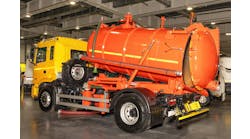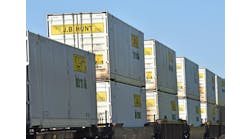U.S. importers had argued, you can't inspect all of the cargo bound for the United States, and Congress listened. Efforts by shipper groups result in a law that includes "multi-layered risk-assessment model" and pilot projects to test the effectiveness and operational ability of 100% container scanning. SAFE Ports Act offers time for the technology and operations capabilities to catch up to the need.
The security challenge is clear as U.S. ports handle more cargo than ever before. August figures for ports surveyed by Global Insight (www.globalinsight.com, Waltham, Mass.) hit 1.44 million twenty-foot-equivalent units (TEUs). This was up 5% from July and is 8.4% ahead of August 2005. August, the latest month for which figures were available, also topped the prior year's peak month of October, which registered 1.37 million TEU. For 2006, September was expected to reach 1.4 million TEUs and October 1.46 million TEUs, 4.9% and 6.5% ahead of the same months in 2005, respectively.
This sustained growth has put strains on infrastructure and also on security. As the 2006 peak shipping season was winding down, reports indicated the ports were operating without congestion and that truck and rail systems were handling the record volumes. That's much improved from recent peak seasons, but the shipping industry and U.S. importers (particularly retailers) were concerned that security regulations before the U.S. Congress would spoil those improvements. Their nemesis was a proposed 100% inspection of inbound containers.
"One hundred percent scanning is currently operationally infeasible, technically unreliable and would cause unacceptably high economic costs and disruptions to the economy while offering no real improvement to the nation's cargo security system," said Erik Autor, international trade counsel for the National Retail Federation (NRF).
NRF members, who account for $1.5 trillion in annual sales, were joined by shipper groups, including the National Industrial Transportation League (NITL), in urging Congress to consider the impact of mandating inspection of the estimated 12 million containers that enter the United States each year. A policy of 100% inspection would significantly impede the flow of commerce and damage the U.S. and global economies, according to the group's statements.
As vehemently as the groups opposed 100% inspection, they were equally enthusiastic over the final bill, the Safe Port Act, HR 4954, that President Bush signed into law. Retailers, industrial importers and the ports congratulated the Congress for its bipartisan efforts that led to the multi-layered risk-assessment model that is part of the final law. The ports are pleased because the law permits multi-year funding that will ease the transition to and acquisition of additional scanning systems.
The Supply Chain Security Coalition (SCSC) noted in its opposition to 100% inspection that it takes an additional one to three days to release a container back into the stream of commerce once it has been identified as "questionable" and targeted for scanning by U.S. Customs and Border Protection (CBP). With 11 million to 12 million containers entering the United States each year, the results of 100% inspection could have been devastating.
The National Industrial Transportation League (NITL) noted that a number of elements that were not related to port security were stripped from the bill. Among the elements stripped from the bill were provisions for rail security improvements on bridges and tunnels as well as mass transit security. The final bill also dropped a study of port security user fees.
That's some of what's out. What is in the final bill?
- Establishment of an Office of Cargo Security Policy.
- $400 million a year over five years for risk-based grants for training and exercises at ports.
- The 22 largest ports must install radiation detectors by the end of 2007.
- The Department of Homeland Security (DHS) must submit a feasibility plan to detect and prevent shielded nuclear and radiological, chemical, biological or other weapons of mass destruction from entering the United States.
- Requirements to provide random inspections of containers.
- DHS will be required to develop protocols to resume transportation and trade following a disruption-causing incident-with priority given to participants in the Customs-Trade Partnership Against Terrorism (C-TPAT).
- Formalize the C-TPAT program, including consequences for non-compliance.
- Enhancements to the Automated Targeting System (which determines which containers are at-risk).
- Requirements for a plan to establish minimum standards and procedures for securing containers within three months.
- Codify the Container Security Initiative (CSI) at selected overseas ports. (CSI recently certified the 50th over-seas port.)
- Provide for pilot programs to evaluate 100% screening for all cargo containers and 100% scanning of all "high risk" containers.
The Retail Industry Leaders Association (RILA) called attention to the pilot programs saying its members were pleased with the decision to ensure that technologies are thoroughly tested in the field before deployment on a system-wide basis.
Viewed as a "must pass" bill, the SAFE Ports Act could have been crusted with barnacles in the form of unrelated amendments, but it carried only one major amendment that had no connection to logistics, a last-minute statute that attempts to stop Internet gambling.


